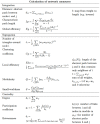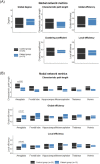Network analysis reveals abnormal functional brain circuitry in anxious dogs
- PMID: 36920933
- PMCID: PMC10016658
- DOI: 10.1371/journal.pone.0282087
Network analysis reveals abnormal functional brain circuitry in anxious dogs
Erratum in
-
Correction: Network analysis reveals abnormal functional brain circuitry in anxious dogs.PLoS One. 2025 Mar 17;20(3):e0320459. doi: 10.1371/journal.pone.0320459. eCollection 2025. PLoS One. 2025. PMID: 40095998 Free PMC article.
Abstract
Anxiety is a common disease within human psychiatric disorders and has also been described as a frequently neuropsychiatric problem in dogs. Human neuroimaging studies showed abnormal functional brain networks might be involved in anxiety. In this study, we expected similar changes in network topology are also present in dogs. We performed resting-state functional MRI on 25 healthy dogs and 13 patients. The generic Canine Behavioral Assessment & Research Questionnaire was used to evaluate anxiety symptoms. We constructed functional brain networks and used graph theory to compare the differences between two groups. No significant differences in global network topology were found. However, focusing on the anxiety circuit, global efficiency and local efficiency were significantly higher, and characteristic path length was significantly lower in the amygdala in patients. We detected higher connectivity between amygdala-hippocampus, amygdala-mesencephalon, amygdala-thalamus, frontal lobe-hippocampus, frontal lobe-thalamus, and hippocampus-thalamus, all part of the anxiety circuit. Moreover, correlations between network metrics and anxiety symptoms were significant. Altered network measures in the amygdala were correlated with stranger-directed fear and excitability; altered degree in the hippocampus was related to attachment/attention seeking, trainability, and touch sensitivity; abnormal frontal lobe function was related to chasing and familiar dog aggression; attachment/attention seeking was correlated with functional connectivity between amygdala-hippocampus and amygdala-thalamus; familiar dog aggression was related to global network topology change. These findings may shed light on the aberrant topological organization of functional brain networks underlying anxiety in dogs.
Copyright: © 2023 Xu et al. This is an open access article distributed under the terms of the Creative Commons Attribution License, which permits unrestricted use, distribution, and reproduction in any medium, provided the original author and source are credited.
Conflict of interest statement
The authors have declared that no competing interests exist.
Figures






References
-
- Asken MJ, Grossman D, Christensen LW. American Psychiatric Association. Diagnostic and Statistical Manual of Mental Disorders. Arlington, VA: American Psychiatric Pub-lishing, 2013. Archibald, Herbert C., and Read D. Tuddenham.“Persistent Stress Reac-tion after Combat: A 20-Year Follow-Up.” Archives of General Psy. Therapy. 2007;45(10):2317–25.
Publication types
MeSH terms
LinkOut - more resources
Full Text Sources
Medical

